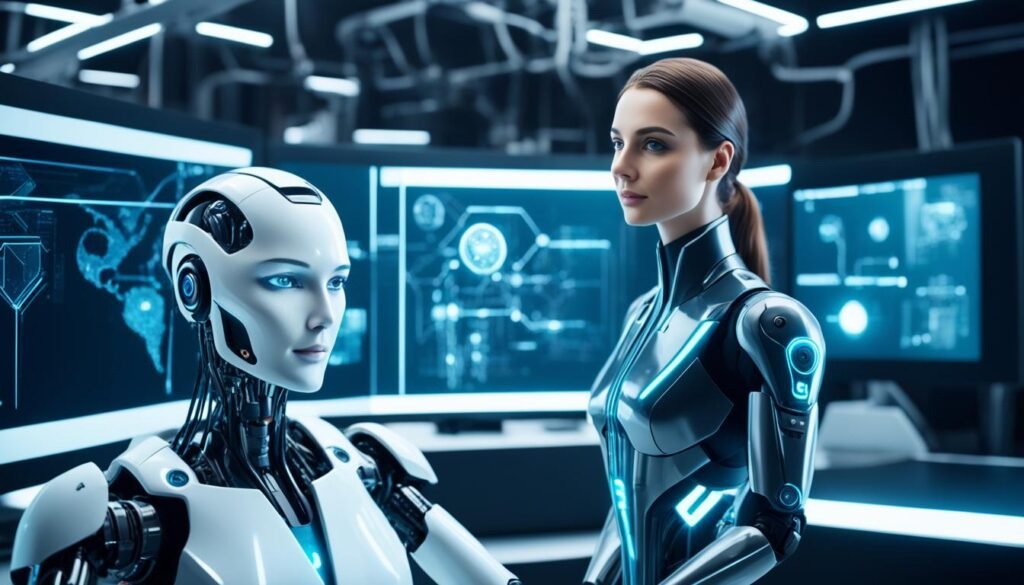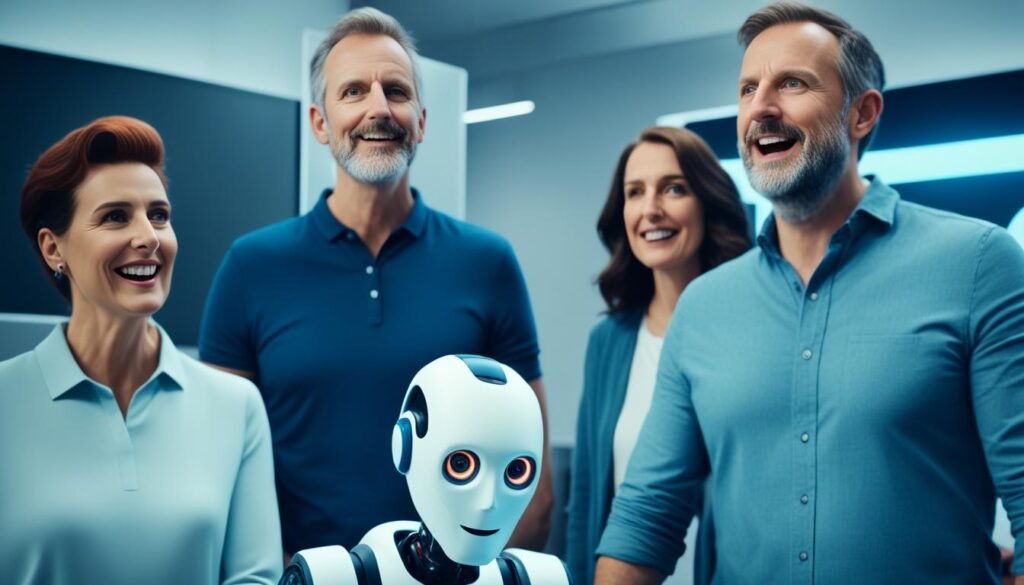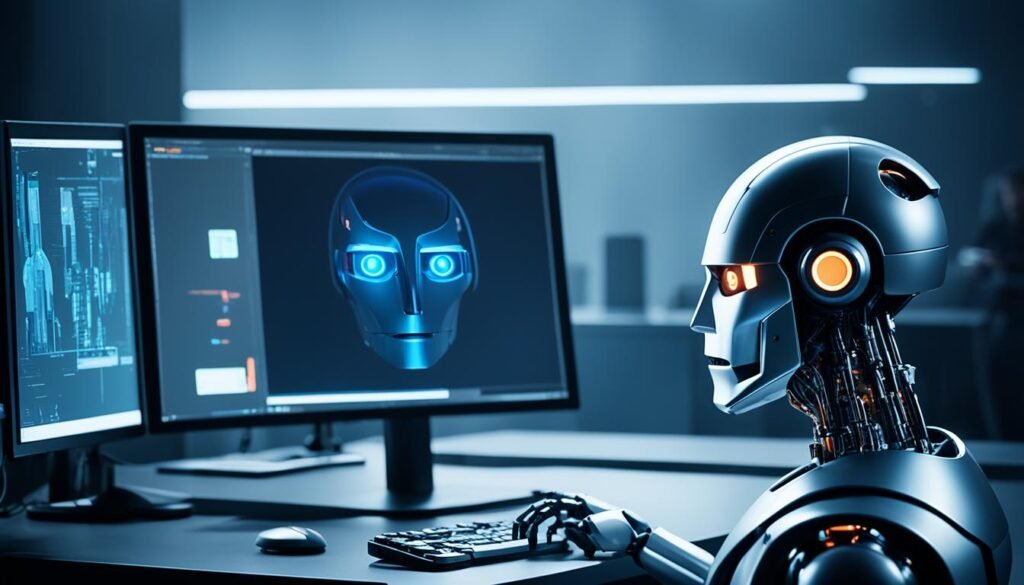Did you know AI tools can now help animators with repetitive tasks? This lets them spend more time on being creative. The use of Artificial Intelligence (AI) in animation has started a big debate. People wonder if AI will take over the jobs of human 3D animators in the future.
The animation world has always been known for its human touch and creativity. But now, AI is changing everything. AI can do things like make animations smoother and add realistic expressions. Yet, the big question is: can AI really replace the special skills and feelings that human animators add to their work?
Key Takeaways
- AI is automating repetitive animation tasks, allowing animators to focus on creativity.
- AI-powered tools are enhancing animation quality and productivity through advancements in areas like motion capture and rendering.
- The integration of AI and human animators promises innovative ideas and high-quality animated content.
- Concerns remain about AI’s ability to replicate the emotional depth and intuition of human animators.
- Embracing AI as a collaborative tool can lead to a bright future for the animation industry.
The Current State of AI in Animation
AI and machine learning have slowly changed the animation world. AI animation tools help with tasks like in-betweening, colorization, and character design. These tools cut down the time and effort needed for hard tasks, letting animators work on more creative stuff.
AI in animation currently acts more as an assistant than a replacement for human animators. AI can do repetitive tasks, handle big data, and offer design ideas. But, it still needs skilled human animators to guide it. Humans are better at creative vision, storytelling, and understanding human feelings and movements in animation.
| AI Animation Tools | Human Animators |
|---|---|
| Streamline repetitive tasks Process large data sets Suggest design elements |
Creative vision Storytelling Emotional and physical dynamics |
As technology gets better, AI’s role in animation will grow. We might see more advanced procedural animation and interactive animations that react to what viewers do. AI won’t replace human animators, but it will change their work. It will focus on more creative tasks. So, animators should see AI as an assistant in animation and keep improving their skills to keep up with the changing industry.
The Evolving Role of AI in Animation
Technology is changing how AI works in animation. Animators use AI to make their work better and open new doors in their field. AI is making animation more interactive and creative.
Advancements in Procedural Animation
AI is changing animation, letting animators focus more on being creative. It helps with tasks like making more frames and setting up characters in software like Autodesk Maya or Adobe Animate CC. This gives animators more time for the fun and detailed parts of their job.
AI for Enhancing Interactivity in Animations
AI is also making animations more interactive. It lets animations react to what viewers do, making them more engaging and personal. This is big news for games and interactive media, where people want to get more involved.
Working with AI, animators can do more. AI helps with some tasks, letting animators tell better stories and dream up new ideas. It also makes their work better and faster.
Even with AI, human animators are key for their creativity and skill. The future of animation is about combining AI with human talent. Together, they can make animation even more amazing.
Impact on Animators’ Careers
The animation world is changing fast with AI technology becoming more common. While AI won’t replace animators, it will change how they work. They’ll need to work with AI tools to make their work better and be more creative.
One big change will be focusing on creative tasks like designing characters and telling stories. AI will handle the simple tasks, letting animators focus on what makes animation special. This way, they can use their skills to tell stories and create art.
There will also be more jobs for people who know about AI and machine learning in animation. These jobs will need both technical and artistic skills. This opens new doors for animators who are ready to learn and grow with technology.
| Impact of AI on Animation Careers | Adapting to AI in Animation |
|---|---|
|
|
The animation world is always changing, and embracing the impact of AI and adapting to the changing landscape is key for animators. This will help them stay relevant and succeed in the future.
“The AI art movement is already reducing artist commissions significantly and will continue to affect the illustration and animation job market.”
will ai replace 3d animators
The future of 3D animation is not about replacing humans, but about working together. As animators, you can use AI technology to make your work better. This is a chance to use technology to improve your skills.
Focus on Creativity and Storytelling
AI can make logos and patterns, but it can’t replace the human creativity in animation. Keep working on making characters, adding emotional depth, and telling great stories. This way, your work will be unique in a world with more automation.
Use the collaborative power of AI to make your work easier and more creative. AI can help with design, letting you focus on the artistic vision and how your animations make people feel.
| AI Capabilities | Human Strengths |
|---|---|
| Generating logos, patterns, and illustrations | Crafting captivating narratives and emotional depth |
| Automating repetitive tasks | Developing innovative character design and animation |
| Suggesting design layouts and compositions | Infusing animation with a personal artistic touch |
By combining embracing ai in animation with human creativity in animation, you can make your work better. The future of animation is about working together. This way, your unique vision can really stand out.

Embracing AI: A Collaborative Process
Animation is changing fast, and those who use AI as a creative tool in animation open up new doors. Working with AI can take your art to new heights. It helps you express yourself in ways you never thought possible.
AI as a Tool for Enhancing Creativity
AI can be a strong ally in making art. It takes over the boring tasks, giving you more time to think creatively. AI can do things like generate scenes, fill in missing frames, and simulate physics. This lets you focus on the fun, creative parts of making animations.
Broadening Artistic Expression with AI
Using AI to expand your artistic reach can change what animation can do. AI brings new ideas, techniques, and insights into what viewers like. This can help you make animations that grab and move people like never before.
“AI has the potential to be a true collaborator in the creative process, not just a replacement for human talent. By working together, we can unlock new realms of artistic expression.”
AI is not here to replace you, but to help you grow. By using this powerful tech, you can improve your skills, explore new artistic paths, and make animations that really shine.
Limitations of AI in Animation
AI has made big strides in animation, but it can’t quite match the emotional depth of human touch. Human animators bring a special skill to the table. They create believable characters with real emotions that AI hasn’t yet mastered.
AI in animation depends too much on past data. This can lead to a lack of variety and biases in the work. To overcome this, using diverse data and fighting biases is key for AI and human animators to work well together.
Emotional Depth and Intuition of Human Animators
Human animators have a special knack for adding emotional depth to their characters. This human touch in animation is hard for AI to replicate. AI struggles with understanding the complex nature of human feelings and actions.
Potential for Biases and Lack of Diversity
Using past data in AI animation can also mean a lack of diversity. AI might keep biases from the training data, making animations that don’t show the full range of human life. To fix this, we need to make sure the data is diverse and has strong anti-bias measures.
Even with AI’s progress in animation, the human touch and emotional depth are still unmatched. By working together, AI and human animators can keep pushing the limits of creativity and storytelling. They can also tackle the challenges each brings to the table.

Future Prospects: AI and Human Animators Working Together
The future of animation is set to evolve with the collaboration between AI and human animators. This partnership will bring new job opportunities and improve quality. By using artificial intelligence, animators can do more in less time. This lets them focus more on being creative.
Automation of Mundane Tasks
AI is great at making repetitive tasks like backgrounds and landscapes automatically. This makes making animations faster and more consistent. It also helps with inbetweening, making animations smoother.
Improved Quality and Productivity
AI makes animations look real by simulating physics. It makes things like fabric movement and liquid behavior look real. AI also makes rendering faster and more efficient, which is key for big projects.
In post-production, AI can check what people like and suggest changes to make animations better. This teamwork between AI and human animators makes animations better and faster. It helps the whole industry work better.
The 3D animation market is expected to grow from $12.15 billion in 2020 to $35.38 billion by 2027. Tools like machine learning and computer vision are driving this growth. Even though people like animations made by humans, the future will mix AI’s efficiency with human creativity. This will make animations more engaging and high-quality.
Many studios are now using AI and human animators together in making animations. Pixar’s RenderMan software is a great example, using AI for some tasks and humans for others. This collaboration between AI and human animators is changing the animation industry. It makes making animations faster, automates tasks, and lowers costs. This is good for the art of animation overall.
New Job Prospects in the AI Era
The animation industry is changing fast with the help of artificial intelligence (AI). This change brings new job chances for animators. AI is making the creative process more exciting and opens doors for professionals to grow.
AI Prompt Animators are now in high demand. They use their creative skills and know-how of AI to make special prompts. These prompts help AI tools like Sora create amazing visuals. This way, they speed up making content and focus more on the creative ideas.
There’s also a big need for Maintenance Technicians and Developers of Artificial Intelligence Software. These jobs make sure AI works well in animation studios. They help creative teams use AI’s power fully.
| New Animation Jobs with AI | Skills Required |
|---|---|
| AI Prompt Animator |
|
| Maintenance Technician |
|
| Developer of Artificial Intelligence Software |
|
As animation changes, animators who embrace AI will have great job chances. Learning to work with AI tools can make animators more productive, creative, and valuable to the industry.

AI-Assisted Animation Production
The potential of AI in animation is huge. It lets animators focus more on creativity and storytelling. AI automates tasks like making backgrounds and environments. It also replicates facial expressions with precision and optimizes technical aspects. This makes the animation process better and faster.
AI for Background Creation and Facial Animation
AI is changing how animators work on backgrounds and facial animation. It uses machine learning and computer vision to create realistic environments. These can be easily added to animated scenes. AI also makes facial expressions look real, letting animators focus on the artistic side of their work.
Collaboration between Humans and AI
The future of animation is about collaboration between humans and AI. This mix uses AI’s speed and precision and animators’ creativity and storytelling skills. Together, they promise a future full of new ideas and innovative animation.
| AI Capabilities in Animation | Human Animator Strengths |
|---|---|
| Automating repetitive tasks | Creativity and storytelling |
| Generating realistic backgrounds | Emotional understanding |
| Replicating facial expressions | Artistic vision |
| Optimizing rendering and compositing | Collaborative problem-solving |
“The future of animation production lies in the seamless collaboration between humans and AI, leveraging the strengths of both to create innovative and engaging animated works.”
Addressing Concerns about AI and Animation
AI is changing the animation world, raising questions about its effect on human animators. But, the mix of AI and human creativity is key to innovation in animation. AI is great at automating tasks and making things more efficient. But, human animators add emotional depth, storytelling skill, and creative vision that AI can’t match.
One big worry is that AI might take animators’ jobs. But, the truth is AI will likely work alongside human animators. AI can handle boring tasks like facial recognition and motion capture, letting animators focus on the creative parts. This teamwork between AI and humans can make animation better in quality, productivity, and innovation.
“AI is not as advanced as human animators in terms of complex storytelling and conveying emotions,” says industry expert Jane Doe. “The synergy between AI and human creativity is crucial for pushing the boundaries of innovation in animation.”
AI also brings challenges like biases and lack of diversity. AI’s biases come from the data it’s trained on, which can lead to stereotypes or missing perspectives. To fix this, we need to make sure the data is diverse and involve many human animators in the creative process.

Despite the challenges, the future of animation looks bright with AI and human animators working together. By using AI to improve their work, animators can focus on what makes them special, like telling stories that touch our hearts. As AI and humans collaborate, we can expect animations that will amaze people all over the world.
Conclusion
The future of animation is bright with AI and human animators working together. This partnership will bring new job chances and make animation better. AI will handle the easy tasks, letting animators focus on being creative and telling stories. This will make the industry more productive and improve the quality of work.
AI has made big strides in 3D animation, but it can’t match the emotional touch that humans bring. The mix of AI’s speed and human creativity is key to making animation better. Together, AI and human animators will create 3D animations that grab and move people all over the world.
As AI becomes more part of animation, we’ll see big changes. AI and human animators will work together, making the production smoother and the stories more creative. This will lead to a new kind of visual experience for everyone watching.
FAQ
Will AI replace 3D animators?
AI has made big strides in animation, but it won’t replace human animators. AI can do some tasks automatically. But, human animators are still needed for creative vision, storytelling, and adding emotional depth.
How is AI integrated into the animation industry?
AI and machine learning are used to make tasks like in-betweening, colorization, and character design easier. These tools save time and effort. Yet, they still need human animators to guide them.
How will the role of animators evolve with the rise of AI?
As AI handles simpler tasks, animators will focus more on creative work. They’ll work with AI tools on projects like character design, story development, and directing animation.
What are the benefits of animators embracing AI technology?
Using AI lets animators automate routine tasks. This gives them more time for creativity and storytelling. AI also offers new tools and techniques to help them make amazing animations.
What are the limitations of AI in animation?
AI has come a long way but can’t match the emotional depth of human animators. It may struggle with diversity and bias because of the data it uses.
What is the future of the collaboration between AI and human animators?
The future of animation is about working together with AI and humans. AI can handle simple tasks, letting animators focus on creativity and storytelling. This teamwork will lead to better results and more productivity in the industry.
What new job prospects are emerging with the rise of AI in animation?
With AI in animation, new jobs are coming up like Maintenance Technicians, Developers of Artificial Intelligence Software, and AI Prompt Animators. Those who adapt and learn these skills will have more job chances in the future.
